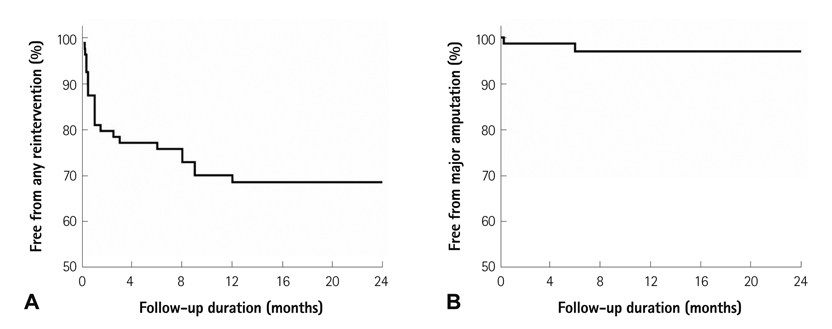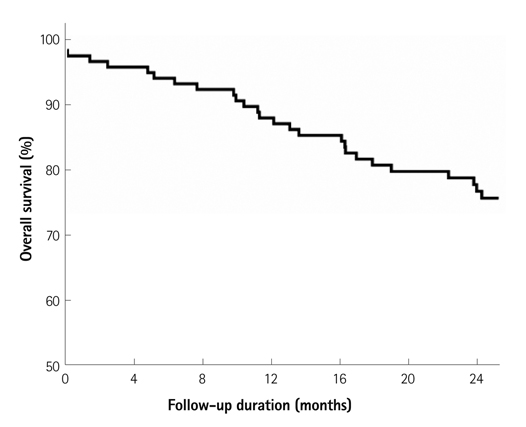Korean Circ J.
2012 Apr;42(4):259-265. 10.4070/kcj.2012.42.4.259.
Clinical Outcomes of Infrapopliteal Angioplasty in Patients With Critical Limb Ischemia
- Affiliations
-
- 1Gumi CHA Medical Center, CHA University, Gumi, Korea.
- 2Severance Cardiovascular Hospital, Yonsei University College of Medicine, Seoul, Korea. cdhlyj@yuhs.ac
- KMID: 2225019
- DOI: http://doi.org/10.4070/kcj.2012.42.4.259
Abstract
- BACKGROUND AND OBJECTIVES
With recent advances in equipment and techniques, infrapopliteal angioplasty has shown results that are comparable to those of surgical bypass in patients with critical limb ischemia (CLI). In this study, we evaluated the efficacy and the feasibility of infrapopliteal angioplasty in patients with CLI.
SUBJECTS AND METHODS
Between March 2002 and May 2008, infrapopliteal angioplasty was performed on 118 limbs of 101 patients (79 males; mean age 66 years) with CLI (Rutherford category 4, 5 or 6). Freedom from reintervention, limb salvage, and overall survival were analyzed.
RESULTS
The median follow-up duration was 30 months. Initial technical and clinical success rates were 69.5% and 83.1%, respectively. No major complication requiring surgical intervention developed after angioplasty. Among 82 limbs with initial technical success, the rate of freedom from any reintervention at 2 years was 70.7% and that from limb salvage was 97.6%. Young age and Rutherford category 6 at initial presentation were independent predictors associated with poor 2 year primary patency in these patients with CLI. Overall survival at 1 year was 86.4% and that at 2 years 76.3%. A history of cerebrovascular accident was an independent predictor associated with poor 2 year survival in these patients.
CONCLUSION
Infrapopliteal angioplasty as a primary choice of treatment in CLI patients showed favorable clinical outcomes and feasibility.
Keyword
MeSH Terms
Figure
Reference
-
1. Blair JM, Gewertz BL, Moosa H, Lu CT, Zarins CK. Percutaneous transluminal angioplasty versus surgery for limb-threatening ischemia. J Vasc Surg. 1989. 9:698–703.2. Treiman GS, Treiman RL, Ichikawa L, van Allan R. Should percutaneous transluminal angioplasty be recommended for treatment of infrageniculate popliteal artery or tibioperoneal trunk stenosis? J Vasc Surg. 1995. 22:457–463.3. Parsons RE, Suggs WD, Lee JJ, Sanchez LA, Lyon RT, Veith FJ. Percutaneous transluminal angioplasty for the treatment of limb threatening ischemia: do the results justify an attempt before bypass grafting? J Vasc Surg. 1998. 28:1066–1071.4. Clair DG, Dayal R, Faries PL, et al. Tibial angioplasty as an alternative strategy in patients with limb-threatening ischemia. Ann Vasc Surg. 2005. 19:63–68.5. Söder HK, Manninen HI, Jaakkola P, et al. Prospective trial of infrapopliteal artery balloon angioplasty for critical limb ischemia: angiographic and clinical results. J Vasc Interv Radiol. 2000. 11:1021–1031.6. Dormandy JA, Rutherford RB. Management of peripheral arterial disease (PAD). TASC Working Group. TransAtlantic Inter-Society Consensus (TASC). J Vasc Surg. 2000. 31(1 Pt 2):S1–S296.7. Schwarten DE. Clinical and anatomical considerations for nonoperative therapy in tibial disease and the results of angioplasty. Circulation. 1991. 83:2 Suppl. I86–I90.8. Hanna GP, Fujise K, Kjellgren O, et al. Infrapopliteal transcatheter interventions for limb salvage in diabetic patients: importance of aggressive interventional approach and role of transcutaneous oximetry. J Am Coll Cardiol. 1997. 30:664–669.9. Siablis D, Kraniotis P, Karnabatidis D, Kagadis GC, Katsanos K, Tsolakis J. Sirolimus-eluting versus bare stents for bailout after suboptimal infrapopliteal angioplasty for critical limb ischemia: 6-month angiographic results from a nonrandomized prospective single-center study. J Endovasc Ther. 2005. 12:685–695.10. Tsetis D, Belli AM. The role of infrapopliteal angioplasty. Br J Radiol. 2004. 77:1007–1015.11. Rutherford RB, Baker JD, Ernst C, et al. Recommended standards for reports dealing with lower extremity ischemia: revised version. J Vasc Surg. 1997. 26:517–538.12. Olin JW. Rutherford RB, editor. Thromboangiitis obliterans (Buerger's disease). Rutherford's Vascular Surgery. 2005. 6th ed. Philadelphia: Elsevier Saunders;404–419.13. Adam DJ, Beard JD, Cleveland T, et al. Bypass versus angioplasty in severe ischaemia of the leg (BASIL): multicentre, randomised controlled trial. Lancet. 2005. 366:1925–1934.14. Feiring AJ, Wesolowski AA, Lade S. Primary stent-supported angioplasty for treatment of below-knee critical limb ischemia and severe claudication: early and one-year outcomes. J Am Coll Cardiol. 2004. 44:2307–2314.15. Krankenberg H, Sorge I, Zeller T, Tübler T. Percutaneous transluminal angioplasty of infrapopliteal arteries in patients with intermittent claudication: acute and one-year results. Catheter Cardiovasc Interv. 2005. 64:12–17.16. Romiti M, Albers M, Brochado-Neto FC, Durazzo AE, Pereira CA, De Luccia N. Meta-analysis of infrapopliteal angioplasty for chronic critical limb ischemia. J Vasc Surg. 2008. 47:975–981.17. Rastogi S, Stavropoulos SW. Infrapopliteal angioplasty. Tech Vasc Interv Radiol. 2004. 7:33–39.18. Criqui MH, Langer RD, Fronek A, et al. Mortality over a period of 10 years in patients with peripheral arterial disease. N Engl J Med. 1992. 326:381–386.19. Golomb BA, Dang TT, Criqui MH. Peripheral arterial disease: morbidity and mortality implications. Circulation. 2006. 114:688–699.20. Balmer H, Mahler F, Do DD, Triller J, Baumgartner I. Balloon angioplasty in chronic critical limb ischemia: factors affecting clinical and angiographic outcome. J Endovasc Ther. 2002. 9:403–410.21. Bailey CM, Saha S, Magee TR, Galland RB. A 1 year prospective study of management and outcome of patients presenting with critical lower limb ischaemia. Eur J Vasc Endovasc Surg. 2003. 25:131–134.22. Kudo T, Chandra FA, Ahn SS. The effectiveness of percutaneous transluminal angioplasty for the treatment of critical limb ischemia: a 10-year experience. J Vasc Surg. 2005. 41:423–435.23. Löfberg AM, Lörelius LE, Karacagil S, Westman B, Almgren B, Berqgvist D. The use of below-knee percutaneous transluminal angioplasty in arterial occlusive disease causing chronic critical limb ischemia. Cardiovasc Intervent Radiol. 1996. 19:317–322.
- Full Text Links
- Actions
-
Cited
- CITED
-
- Close
- Share
- Similar articles
-
- Endovascular Management for Infrapopliteal Stenocclusive Lesions Manifestating Critical Limb Ischemia
- RE: Percutaneous Angioplasty in Diabetic Patients with Critical Limb Ischemia
- Infrapopliteal Percutaneous Transluminal Balloon Angioplasty: Clinical Results and Influence Factors
- A case of subintimal balloon angioplasty in Buerger's disease
- The Usefulness of Infrapopliteal Percutaneous Transluminal Angioplasty in the Treatment of Diabetic Gangrene



